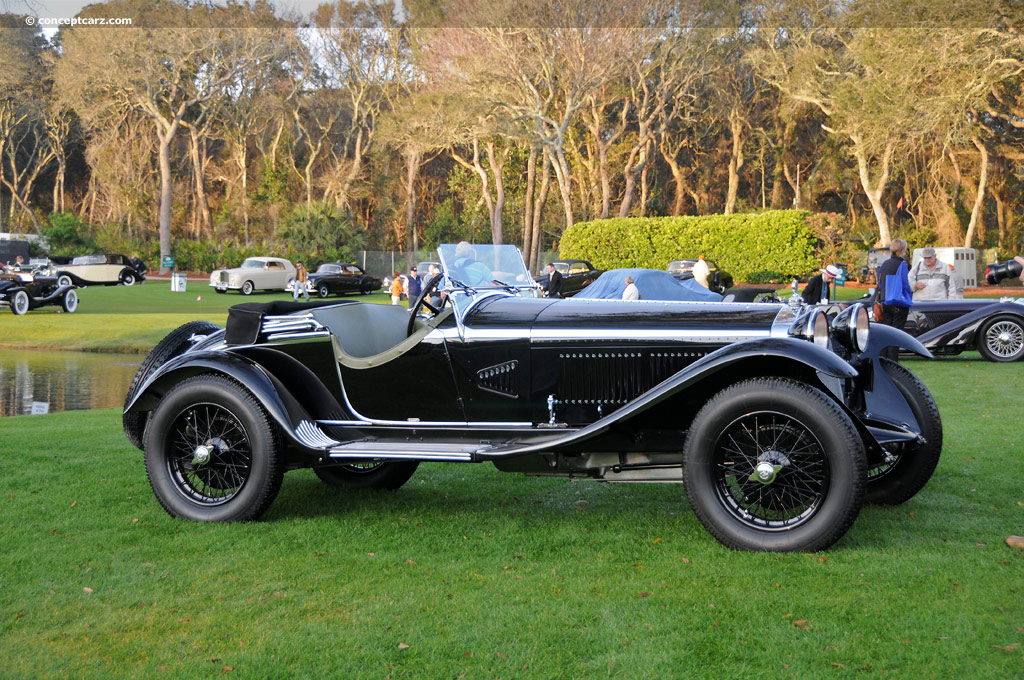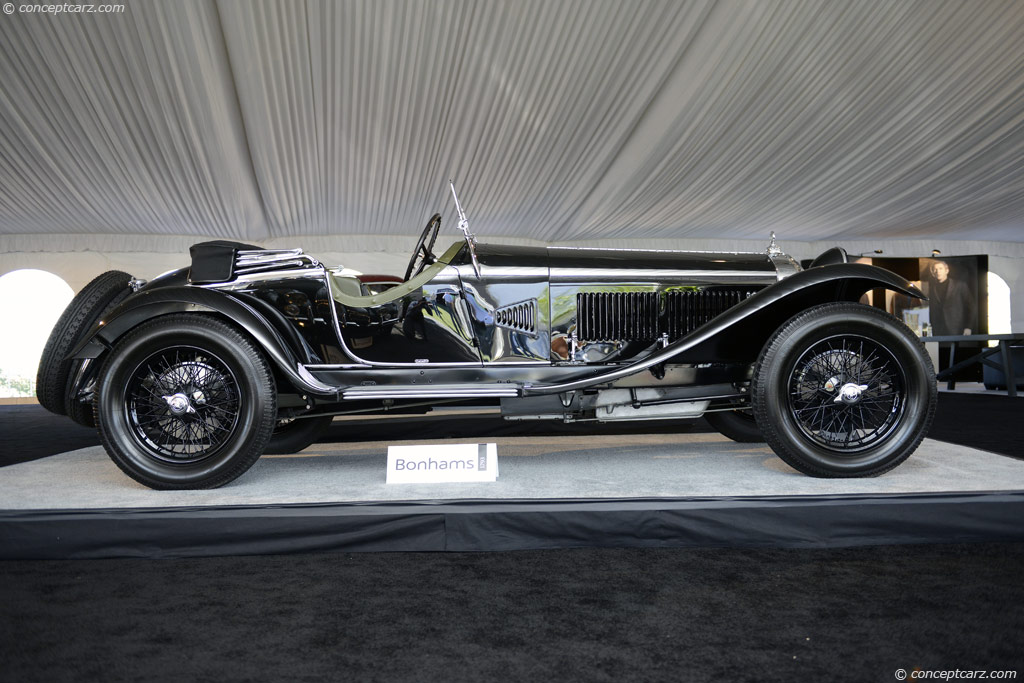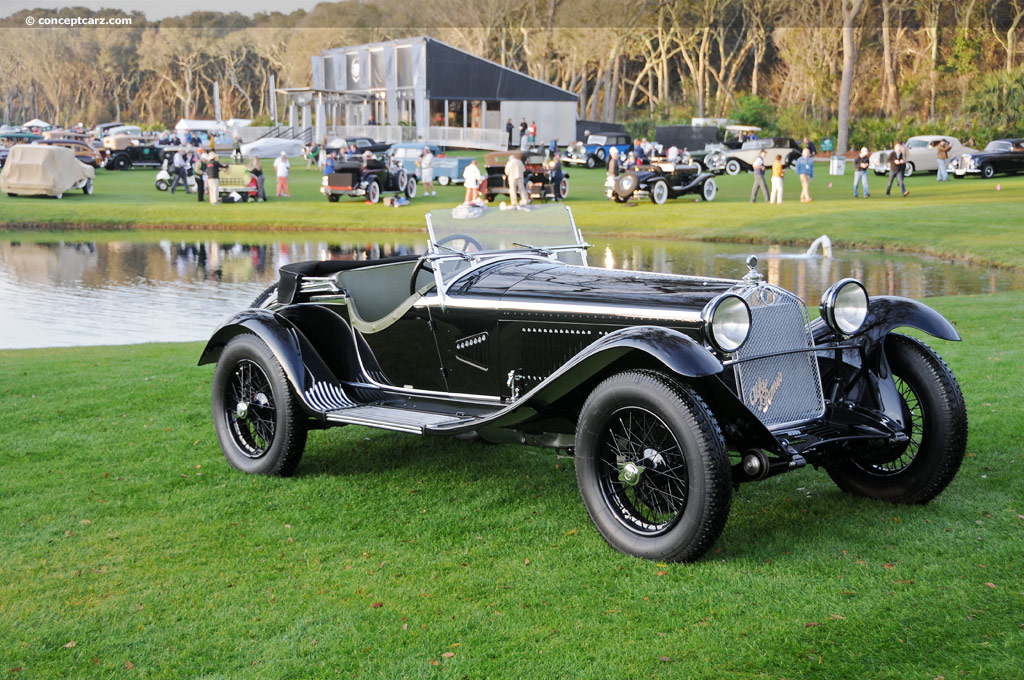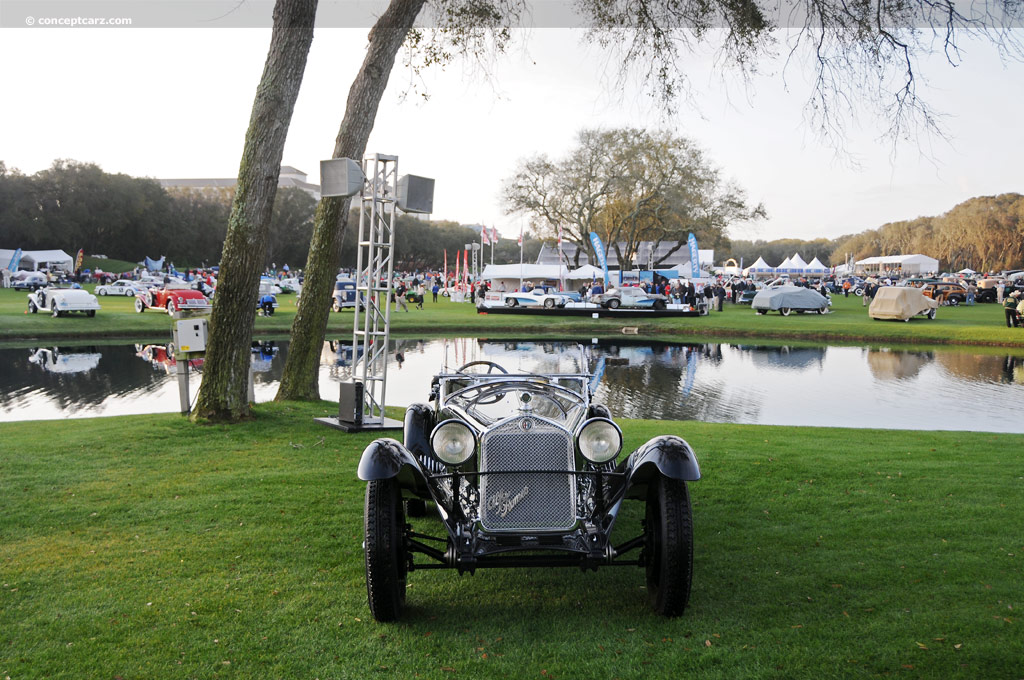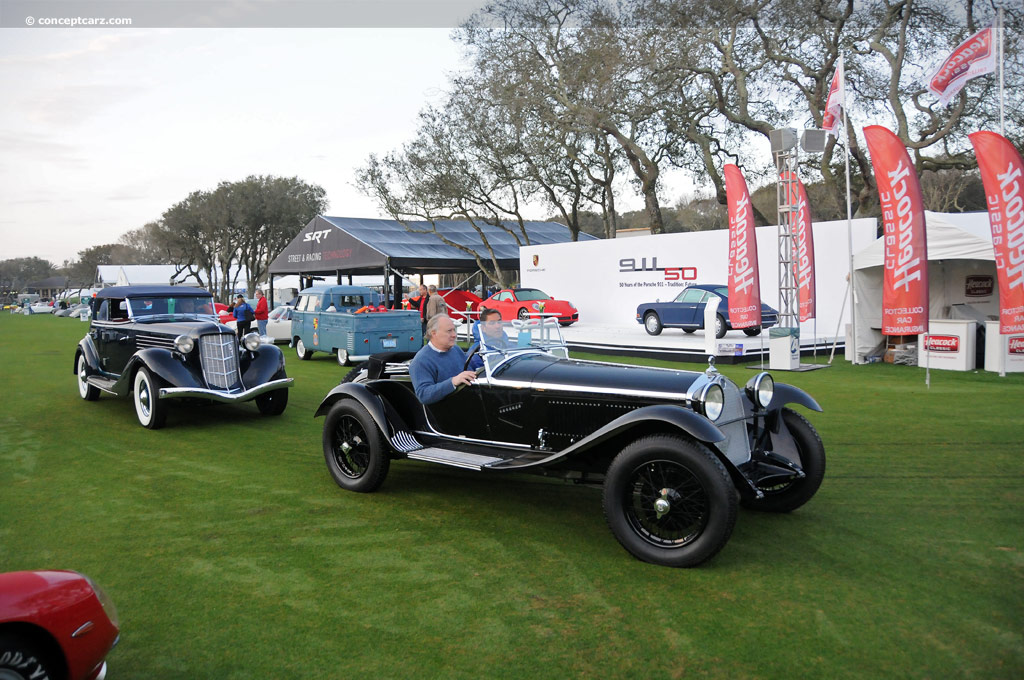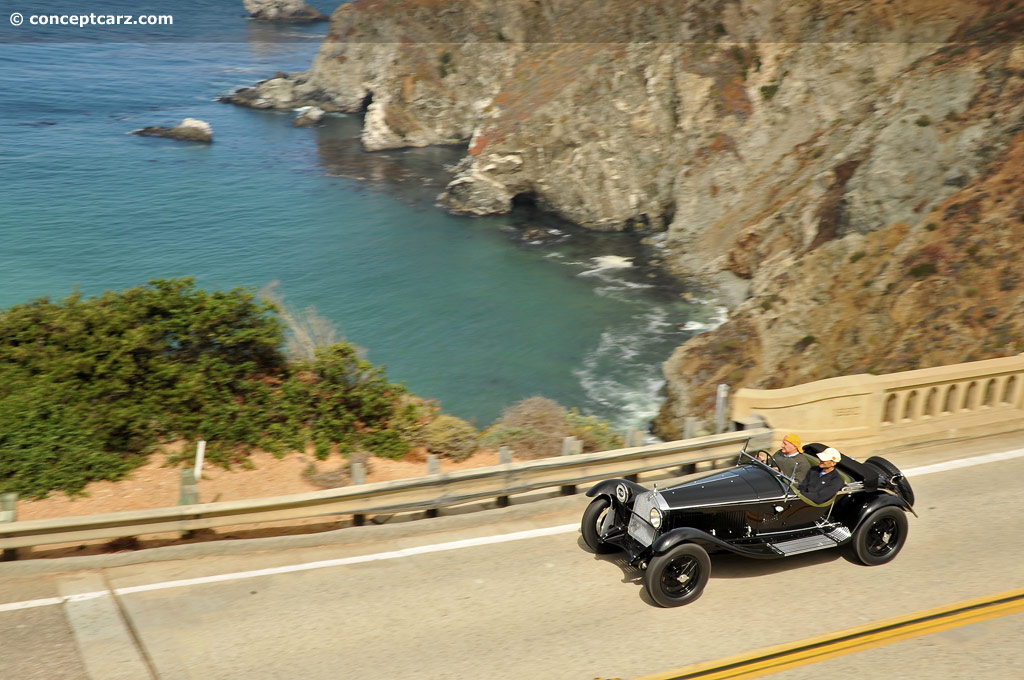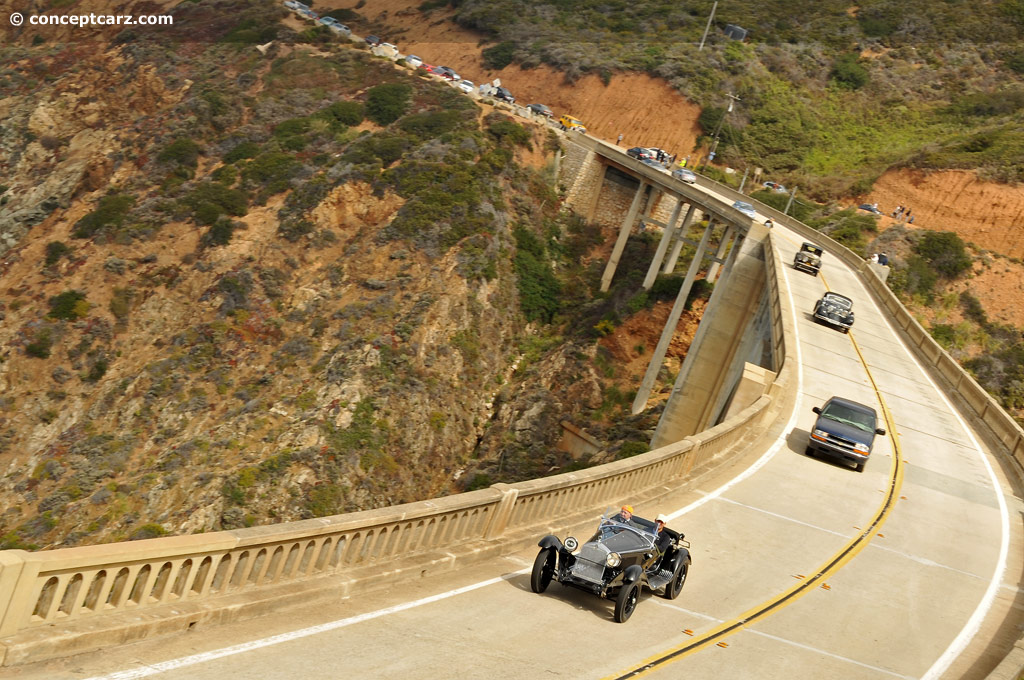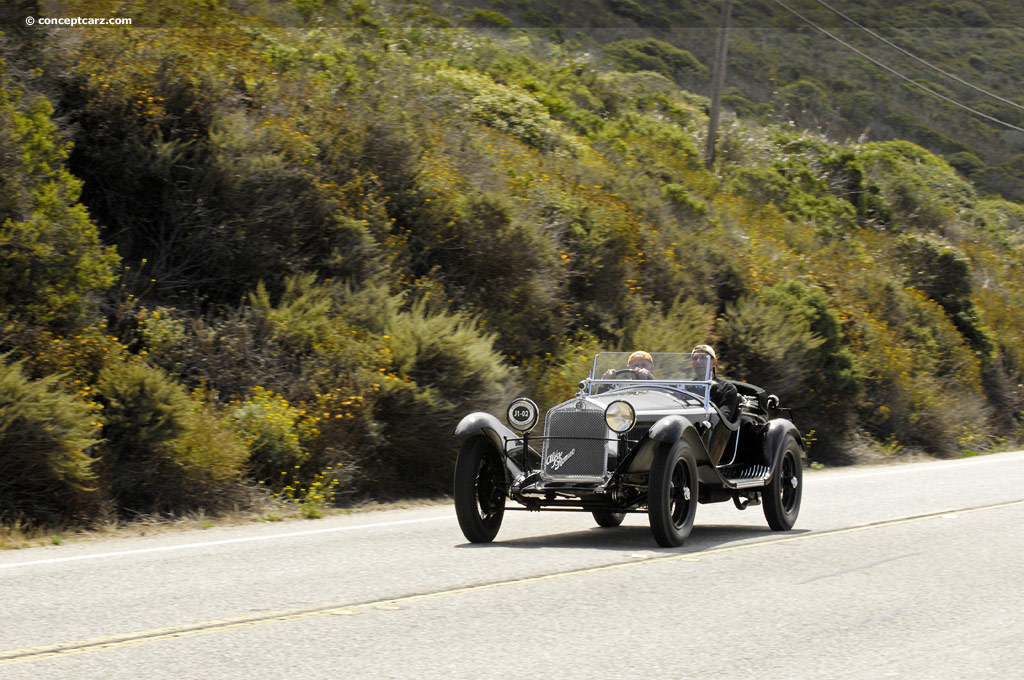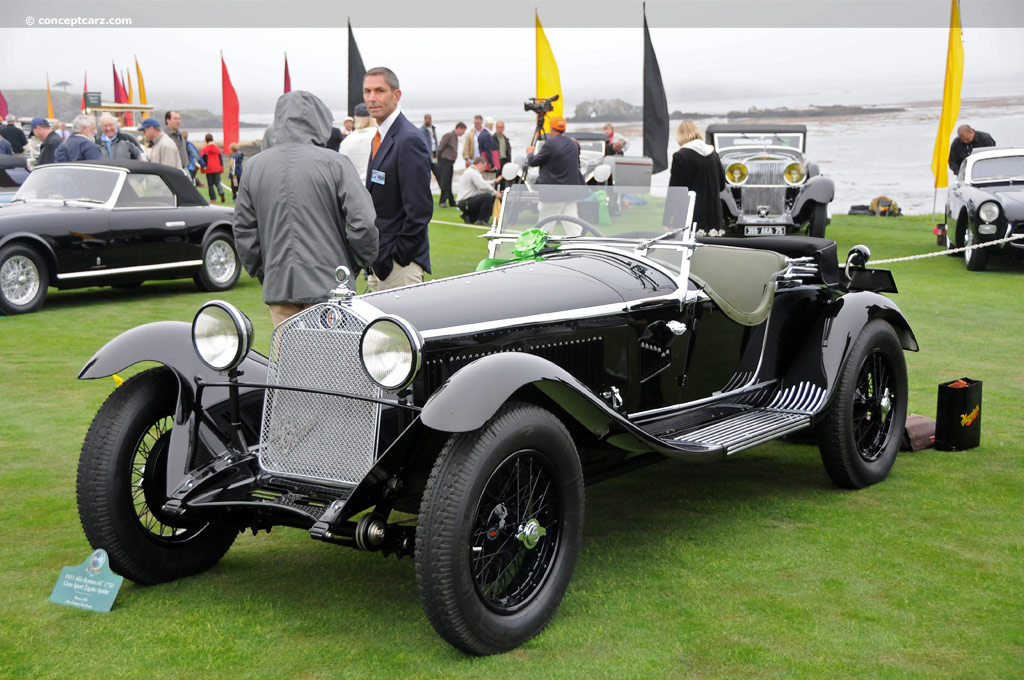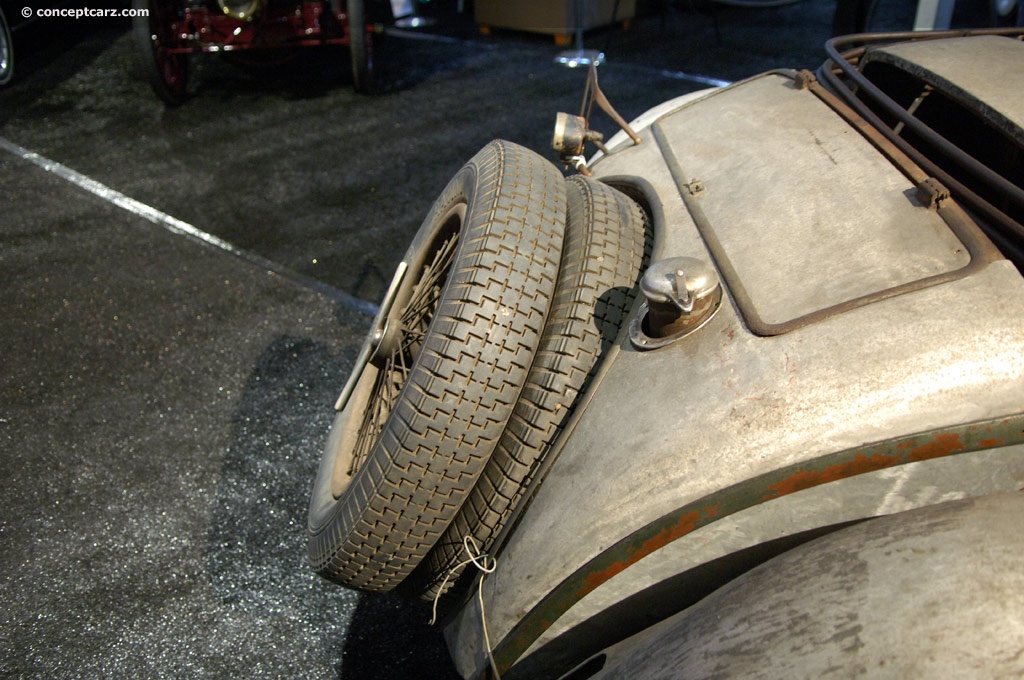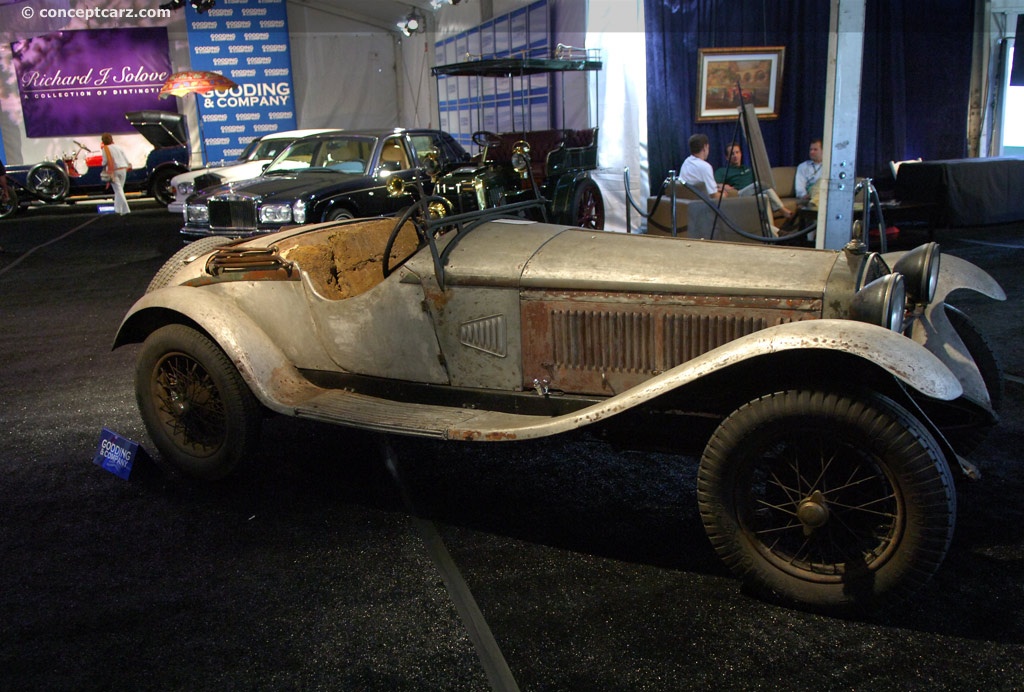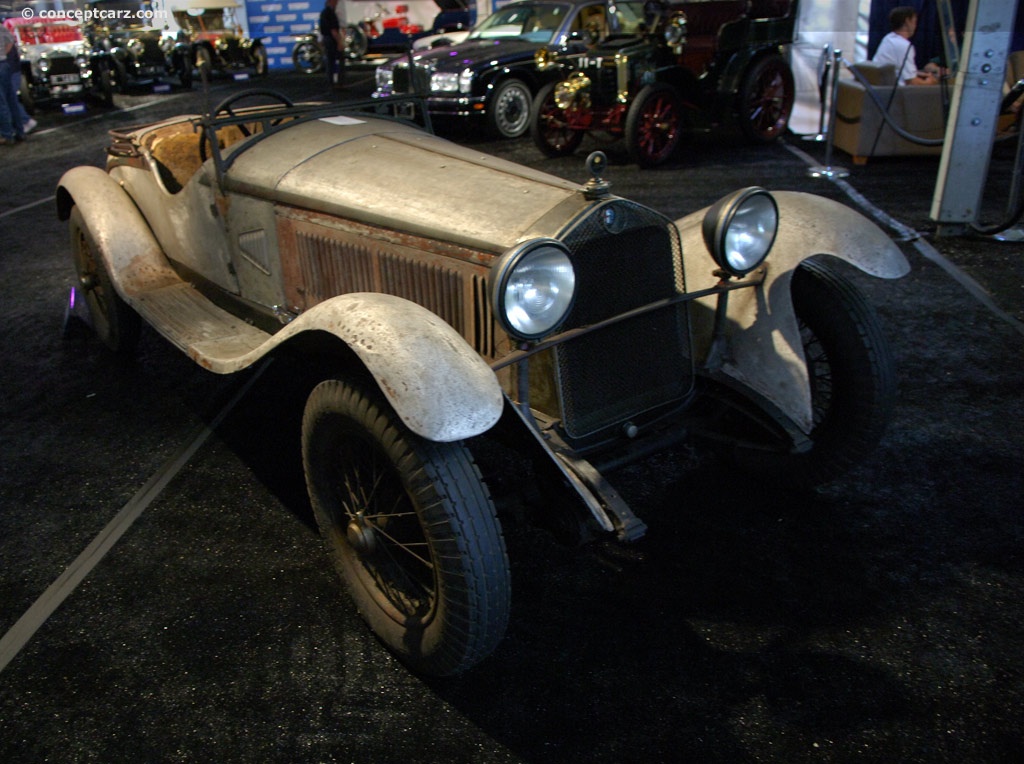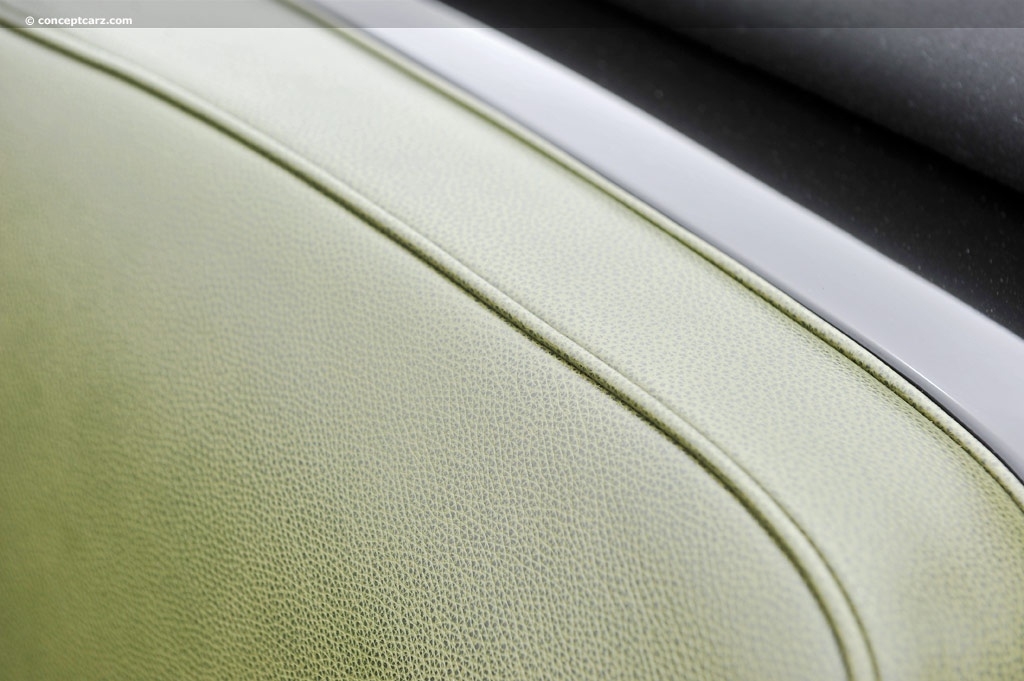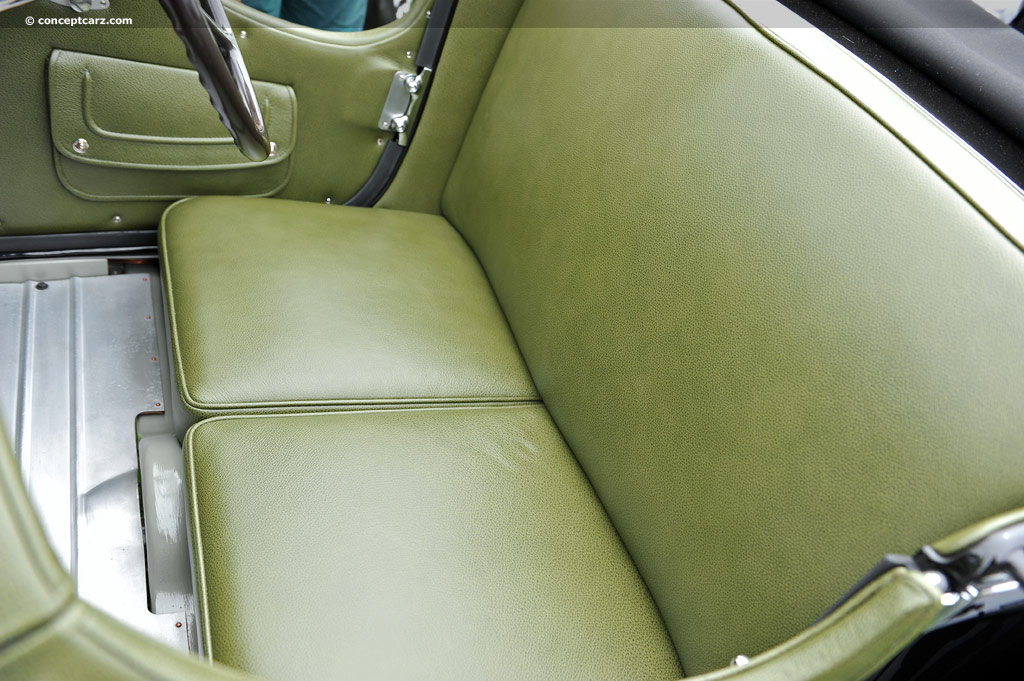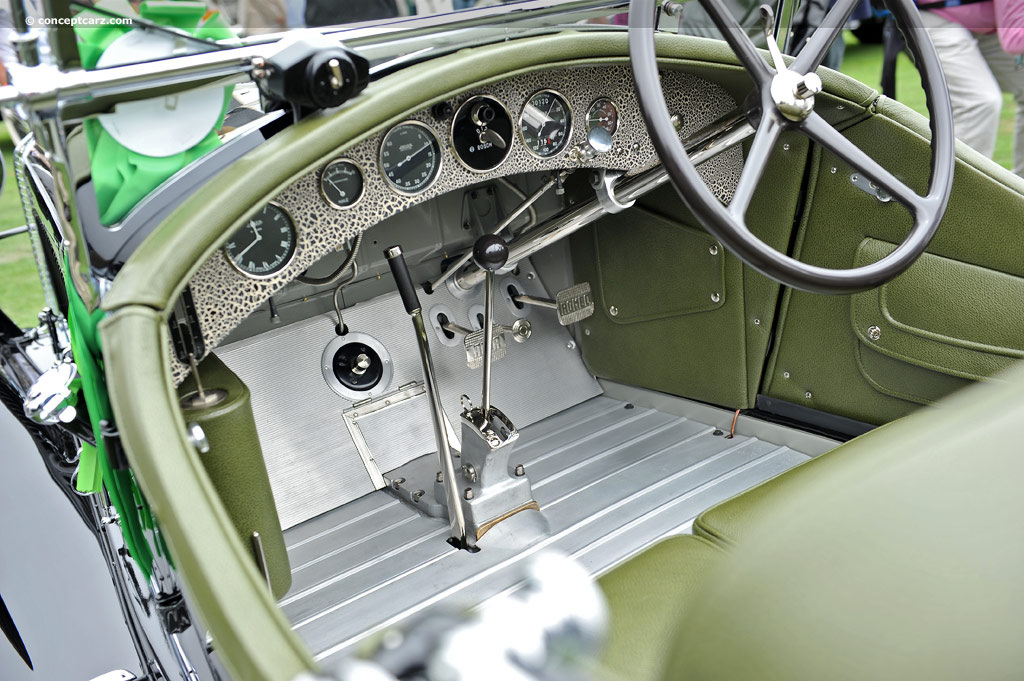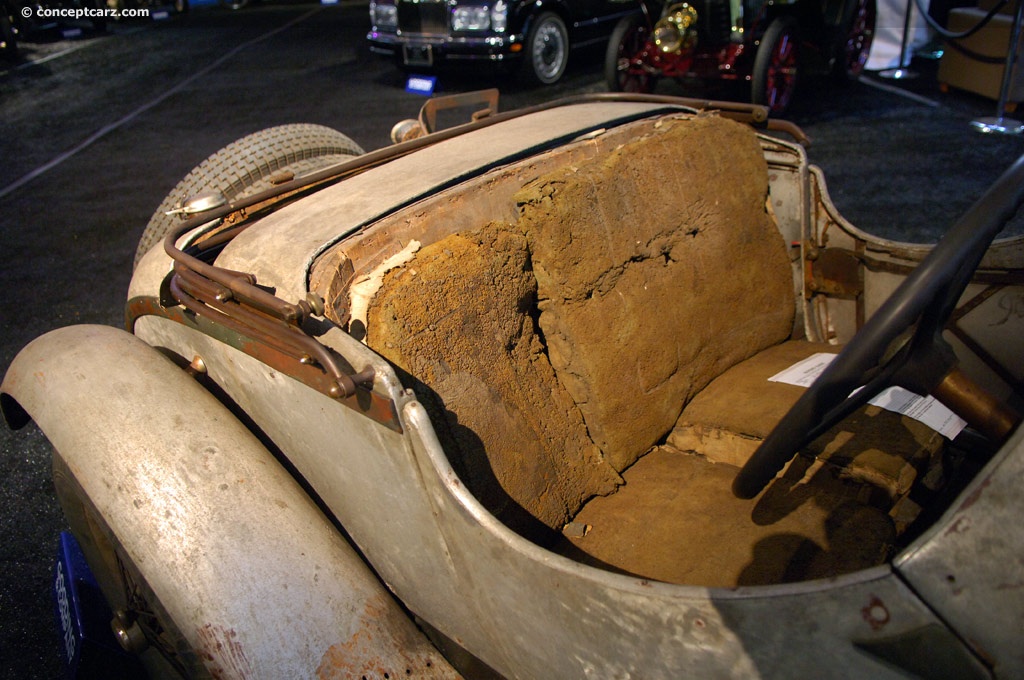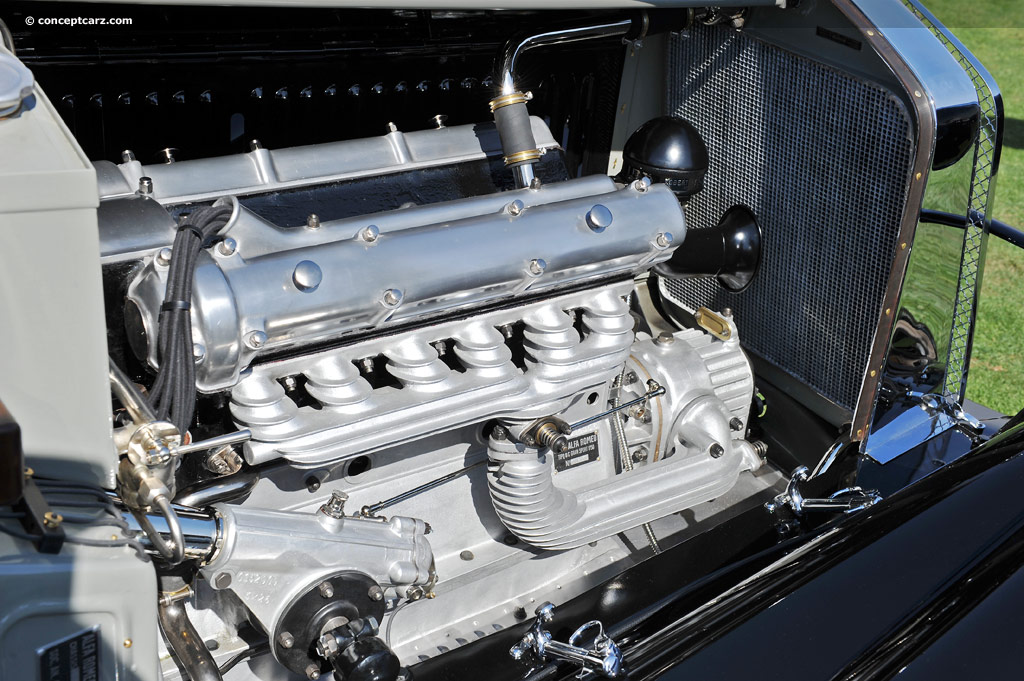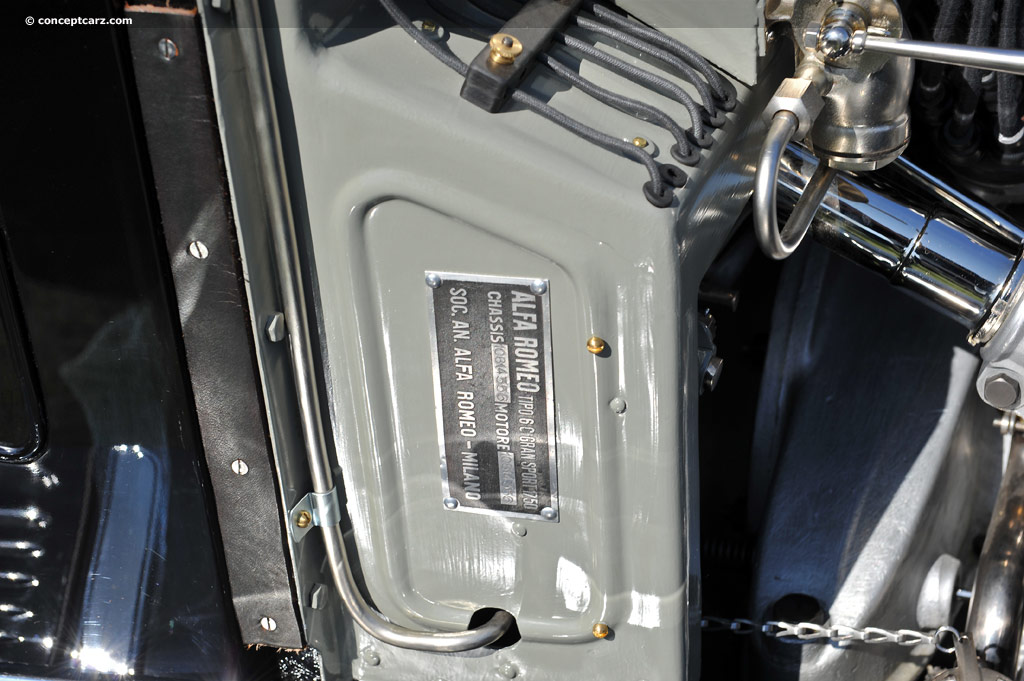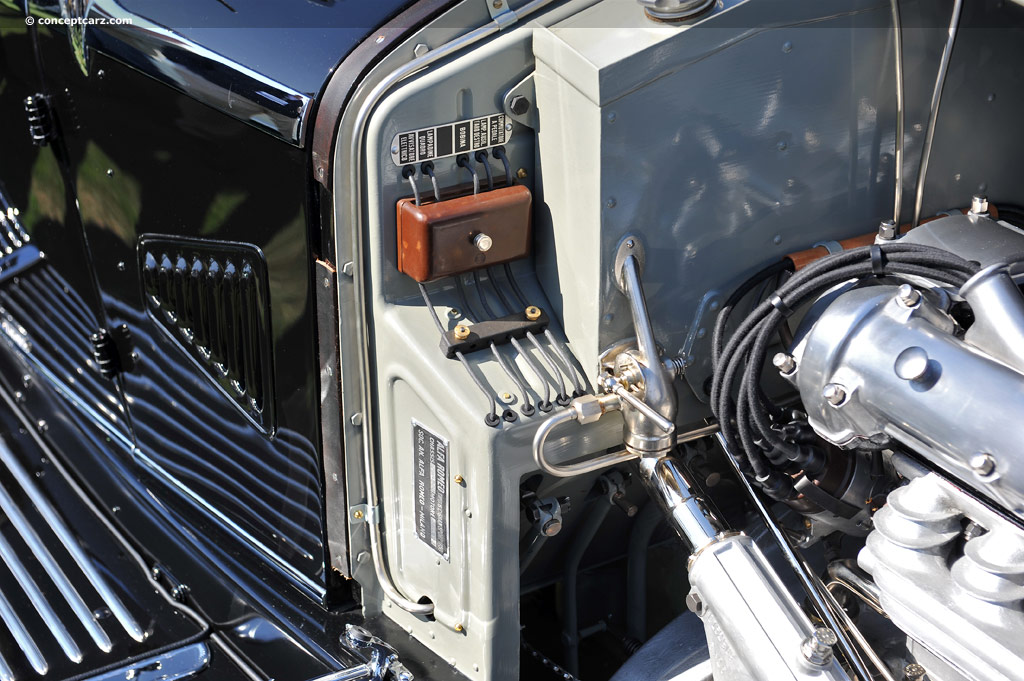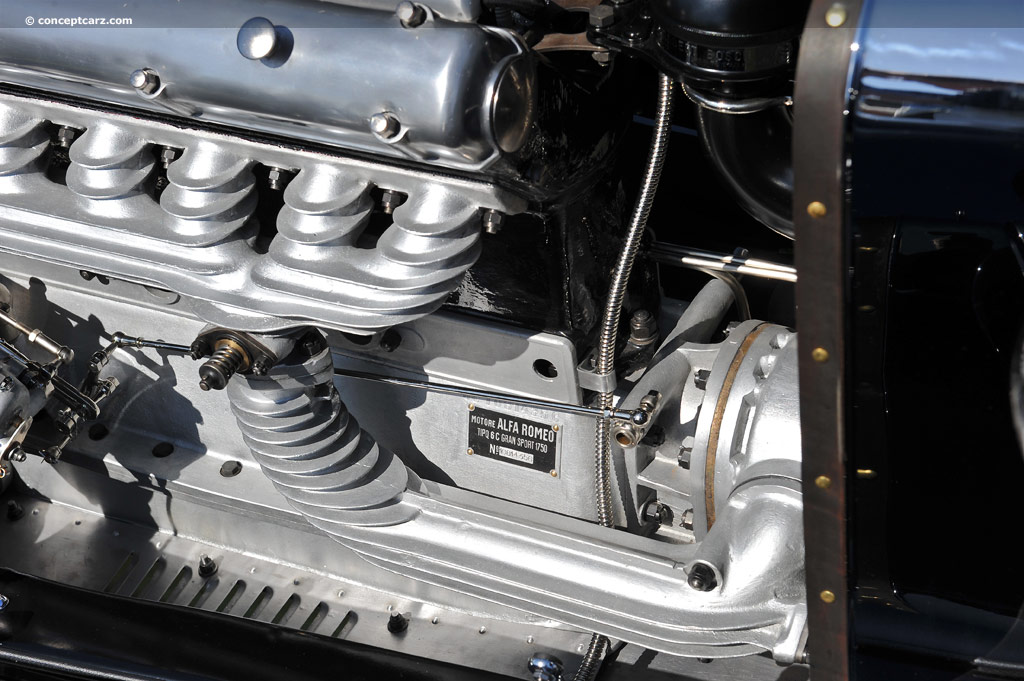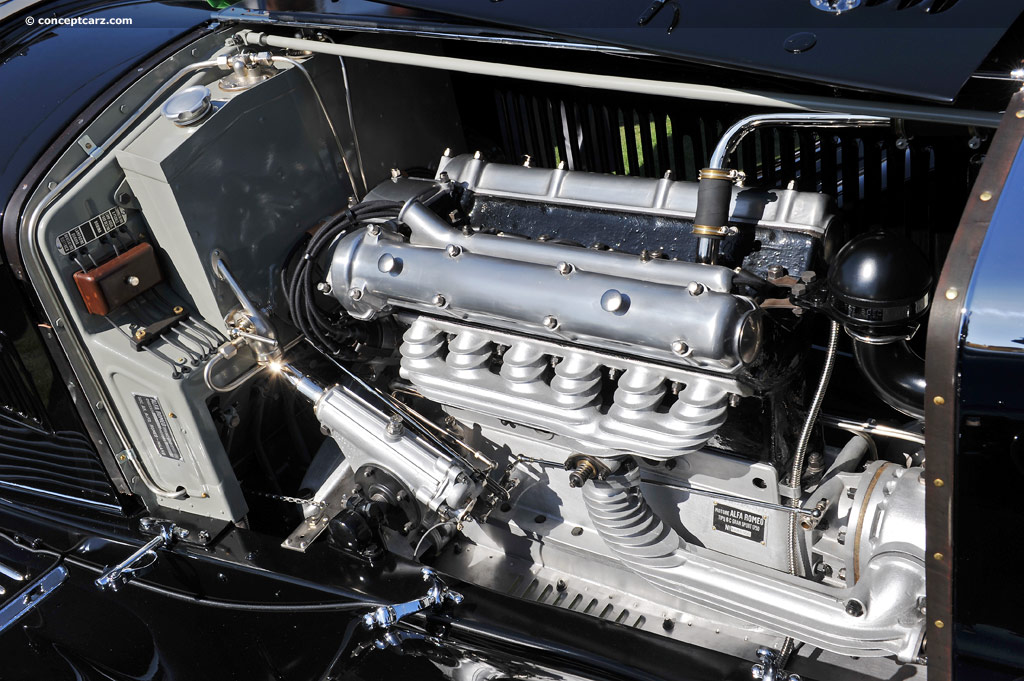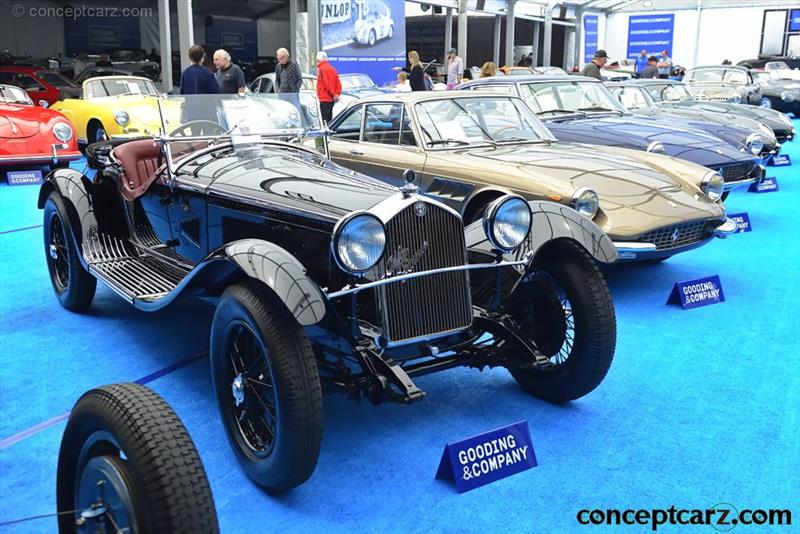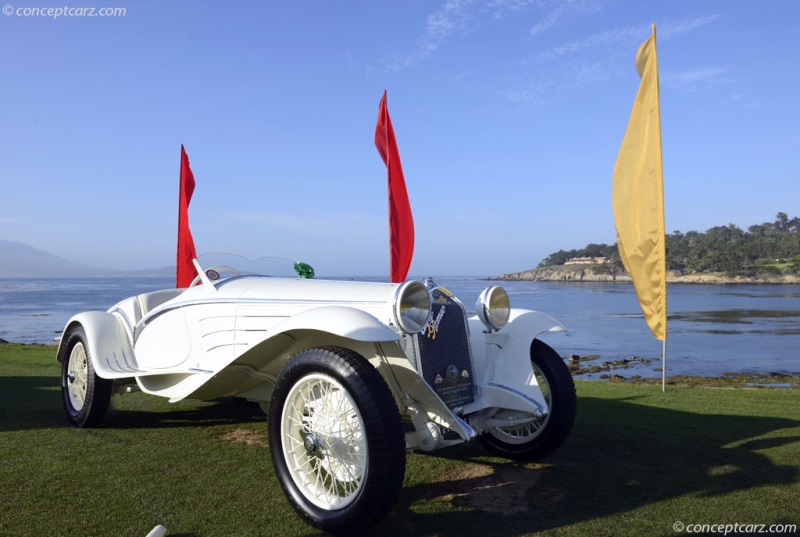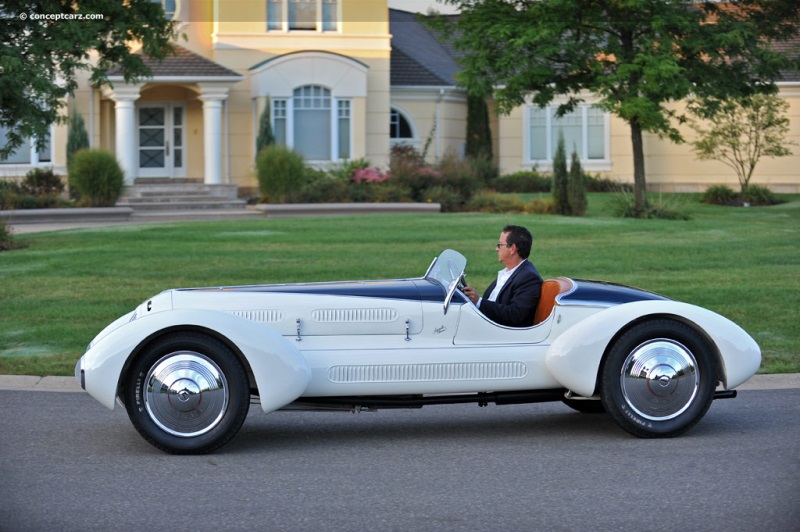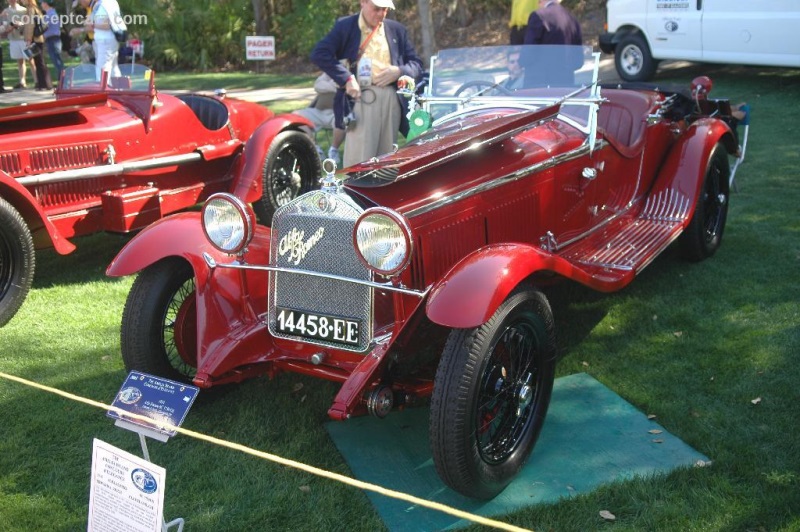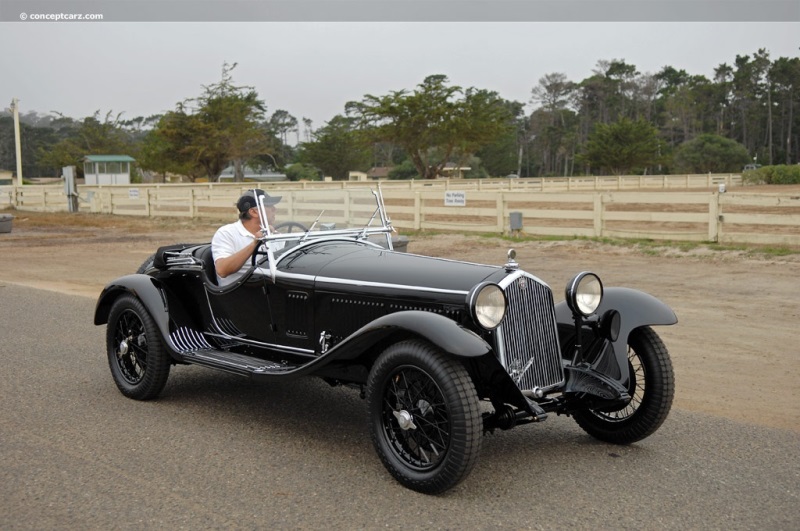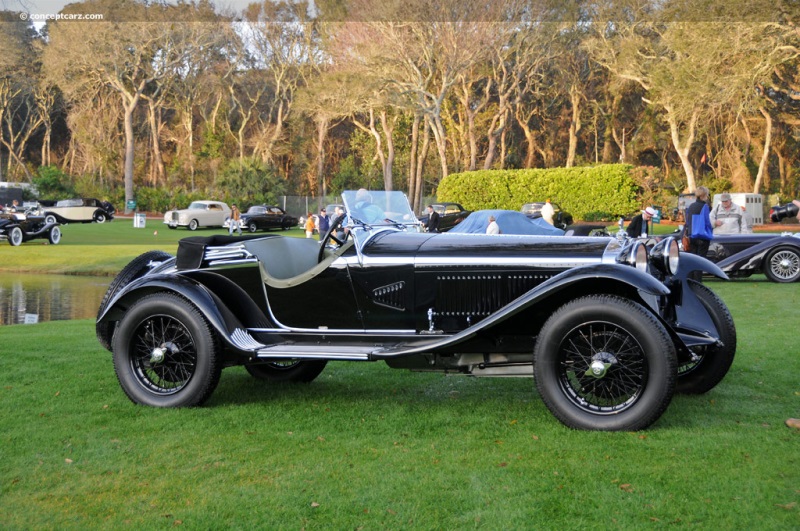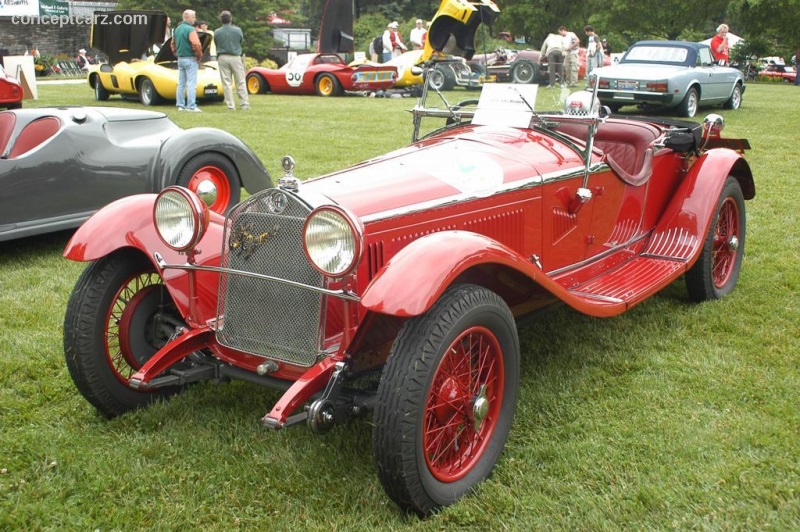Image credit: © conceptcarz.com (Reproduction Or reuse prohibited).
In 1927 the 1500cc single overhead cam six-cylinder engine was introduced to the Alfa Romeo stable, and over the next five years would undergo many modifications, updates, and improvements. The following year the engine had been given two overhead cams and an increase in power. By 1929, the displacement had been increased to 1752cc where it would remain through 1932. In total, fewer than 400 examples of the 67 1750 SS and GS cars were constructed.
The heroic capabilities of the engine were first seen in 1982 when Giuseppe Campari won the grueling Mille Milgia with the first of the 6C 1500 supercharged Zagato Spyders. From there, Alfa Romeo's domination in the sports car racing scene would continue to escalate. Campari would repeat his victory in the Mille Miglia in 1930, this time with a 6C 1750 Zagato Spyder driven in the 2000cc class. Pirola and Guidotti won their 1500cc class in a 6C 1500. Seven of the top ten places that year were Alfa Romeos.
Alfa Romeo's success in competition continued with their 8C 2300. In 1950 an Alfa Romeo Tipo 159 Zagato-bodied car won the first Grand Prix World Championship.
This 1931 Alfa Romeo 6C 1750 Zagato Spyder is equipped with the supercharged engine that provided 85 horsepower at 4400 rpm. It is from the fifth series of production and wears coachwork by Zagato. It was first registered on August 10th, 1931 in the village of Saint Varent in Southwest France to Baron Phillipe de Gunzbourg. It was given the registration number 493 XL1.
It is believed that Baron used this car in motor racing with several notable successes. On June 5th of 1932, he won the 2000cc class at the La Mothe Ste Heraye hill climb and another class victory on June 12th at the Pumoyen hill climb.
In 1933 the Baron co-drove an 8C 2300 Alfa Romeo to second place at the 24 Hours of LeMans with Luigi Chinetti.
de Gunzbourg owned this car until September 1935, when it was registered in the department of Basses Pyrenees with registration number 5906 NM2. On May 14th of 1940, ownership passed to the aircraft manufacturing company Hydravions F.B.A. of Argenteuil near Paris and registered 5922YC2.
On June 5th, 1944, the car was purchased by Victor Polledri, a friend of Luigi Chinetti. It was given the Paris registration number 3081RN4. The car would remain in his possession until the late 1960s when it was sold to M. Barriere who used it sparingly until his death. Upon his death, the car passed to his son. While in his son's care, the engine was rebuilt, and the Zagato coachwork was stripped to bare metal. Little was done after that; it was sold in the early 1980s to its last owner. The car has been stored in unrestored condition since that time.
In 2007 it was offered for sale at the Gooding & Company auction held in Pebble Beach, California, where it was estimated to sell for $900,000 - $1,200,000. An unmolested supercharged Alfa Romeo Zagato Spyder 6C 1750 rarely comes to market. As the gavel fell for the third and final time, the lot had been sold for the sum of $946,000, including the buyer's premium.By Daniel Vaughan | Apr 2008
The heroic capabilities of the engine were first seen in 1982 when Giuseppe Campari won the grueling Mille Milgia with the first of the 6C 1500 supercharged Zagato Spyders. From there, Alfa Romeo's domination in the sports car racing scene would continue to escalate. Campari would repeat his victory in the Mille Miglia in 1930, this time with a 6C 1750 Zagato Spyder driven in the 2000cc class. Pirola and Guidotti won their 1500cc class in a 6C 1500. Seven of the top ten places that year were Alfa Romeos.
Alfa Romeo's success in competition continued with their 8C 2300. In 1950 an Alfa Romeo Tipo 159 Zagato-bodied car won the first Grand Prix World Championship.
This 1931 Alfa Romeo 6C 1750 Zagato Spyder is equipped with the supercharged engine that provided 85 horsepower at 4400 rpm. It is from the fifth series of production and wears coachwork by Zagato. It was first registered on August 10th, 1931 in the village of Saint Varent in Southwest France to Baron Phillipe de Gunzbourg. It was given the registration number 493 XL1.
It is believed that Baron used this car in motor racing with several notable successes. On June 5th of 1932, he won the 2000cc class at the La Mothe Ste Heraye hill climb and another class victory on June 12th at the Pumoyen hill climb.
In 1933 the Baron co-drove an 8C 2300 Alfa Romeo to second place at the 24 Hours of LeMans with Luigi Chinetti.
de Gunzbourg owned this car until September 1935, when it was registered in the department of Basses Pyrenees with registration number 5906 NM2. On May 14th of 1940, ownership passed to the aircraft manufacturing company Hydravions F.B.A. of Argenteuil near Paris and registered 5922YC2.
On June 5th, 1944, the car was purchased by Victor Polledri, a friend of Luigi Chinetti. It was given the Paris registration number 3081RN4. The car would remain in his possession until the late 1960s when it was sold to M. Barriere who used it sparingly until his death. Upon his death, the car passed to his son. While in his son's care, the engine was rebuilt, and the Zagato coachwork was stripped to bare metal. Little was done after that; it was sold in the early 1980s to its last owner. The car has been stored in unrestored condition since that time.
In 2007 it was offered for sale at the Gooding & Company auction held in Pebble Beach, California, where it was estimated to sell for $900,000 - $1,200,000. An unmolested supercharged Alfa Romeo Zagato Spyder 6C 1750 rarely comes to market. As the gavel fell for the third and final time, the lot had been sold for the sum of $946,000, including the buyer's premium.By Daniel Vaughan | Apr 2008
Often times it is our decisions in the midst of seeming impossibility that makes the difference. Two such important decisions would surround a seemingly innocuous 1931 Alfa Romeo 6C 1750.
The first of these important decisions would take place in 1923. Enzo Ferrari was a man with a vision, but getting others to believe in that vision, to even listen to it, were few and far between. What he needed was a trump card, that carrot he could dangle that no one would deny as proof his vision would come to pass. That trump card was Vittorio Jano. Unfortunately, Jano was already employed at FIAT. He knew Ferrari, but knowing the man from Modena was entirely different from believing in his vision for the future. Jano, however, would decide against the established notion and would leave FIAT to come to Alfa Romeo.
The carrot Ferrari dangled before Alfa Romeo and Jano was a racing program that would be greater than any other in Europe. It would be a grand vision, but both sides would buy into it, although it was Jano that put the argument over the top for Alfa Romeo.
The other important decision would take place more than a decade later when the German military was marching, at will, across Europe. Philippe de Gunzbourg was a young man with means. The de Gunzbourg family was a wealthy Jewish family originally from Russia. Philippe's grandfather, Horace, was into banking and property ownership. And, early in the 20th century, he would be presented with an opportunity to invest in a Dutch petroleum company by the name of Royal Dutch Shell. Along with the Rothschilds, Horace would invest in the company. The result would be that by the time Philippe came of age, he would have his choice of outlets as to where he would put his time and efforts.
It was the 1920s and 30s, it was a time of great adventure and intrigue. No longer did the affluent remain in the back, chauffeured around in immense limousines. The majority of the affluent youth would use the wealth available to them to live lives of adventure and discovery. Philippe would be no exception, but the wealth did not mean he was weak of will.
Gunzbourg would reject the elite social scene, the life of lavish parties and stuffy environments. Instead, he would be drawn in by the adventure of aviation and motor racing. If he wasn't pushing the limits in an airplane, he was skirting the ragged edge in some of the best motor racing cars of the period.
However, by the late 1930s, the German military was on the march. A world war was inevitable. Philippe was married with children. He had the means to escape and enjoy his wealth while being protected from the current events of the world. He would do this for his wife and children, but not for himself. Though he would purchase a home in France seemingly far out of the reach of the war, it would soon become apparent there was little escape from the battle of arms. Still, instead of fleeing, the Jewish boy would determine to make himself useful to the French arm of the Special Operations Executive, or, SOE. Disregarding safety for himself, Gunzbourg would work closely with the French Resistance and would barely avoid capture by the Nazis more than a couple of times over the course of the war.
When the war came to an end, his selfless act would be recognized. As a result of his efforts, De Gaulle himself would honor Gunzbourg having the town square of the village of Bergerac named after Philippe.
So these would be two examples where decisions in the midst of great danger or impossibility would have profound consequences. But what is even more incredible is that these two events would be connected by none other than a car.
Jano's first effort for Alfa Romeo would be the 6C 1500. This car would serve as a good basis for the future, but it was not the racing machine Ferrari envisioned. But Jano wasn't done; he was just getting started.
His follow-up to the 1500 would be the 1750, and this car would end up being a leap forward for Alfa Romeo and its racing aspirations. The 1750 would be practically identical to the 1500 with the exception of an engine with a larger displacement. The Sport model would be debuted after the first model of the 1750 would be unveiled. The Sport would have a shorter wheelbase and a supercharged engine producing nearly 100hp. When combined with the 6C chassis, Alfa Romeo would have the basis from which grand prix and sports cars would come for nearly the next decade.
While Alfa Romeo would build the chassis and the engine, coachbuilders like Zagato and Touring would be tasked with creating tidy bodies to sit atop the lightweight chassis. One of the most romantic examples, one of the most evocative, would be designed and built by Zagato.
Based in Milan, Zagato would get its start in automobiles and airplanes. Therefore, the company was already familiar with aerodynamic and tight designs and how they affected performance, and this was at a time when aerodynamics was still very much a new and under-investigated science.
One example of the 6C 1750 Zagato would have a hand in building would be 10814356. It would be this car that would connect the story of Ferrari, Jano, and Alfa Romeo with Gunzbourg and war-torn Europe.
Alfa Romeo would complete its work on the chassis in 1931. The chassis would be a fifth series Gran Sport Spider meaning it would have a supercharged 1750 cubic inch dual overhead cam, all-aluminum, engine. The place within the series in which 10814356 occupies also meant that when the chassis and engine made the trip to Zagato, it would receive the updated and more refined body.
The car would be completed and shipped to France in August 1931, where it would be united with its first owner—Philippe de Gunzbourg. Though 27 at the time, Gunzbourg was deeply motivated in his racing career. After having scored so impressive results in hill climbing events, he would turn his attention to sports car racing. In fact, Gunzbourg's name would pass down through Le Mans history as a result of his partnering with the legendary Luigi Chinetti in the 1933 24 Hours of Le Mans.
In spite of his relative inexperience, Gunzbourg would partner with Chinetti to finish an impressive 2nd with an Alfa Romeo 8C 2300. It is widely held that the 6C 1750 was his personal car that he used to get around Le Mans at the time of the historic race.
Although Gunzbourg would remain in Paris, even with the coming German military fast approaching, the Alfa Romeo 6C 1750 would actually be separated from him by 1935. That year, he would sell the car to a resident living in the region near the Pyrenees. The car would remain in this area until 1940, when it would again be sold and moved to Paris. It would actually be registered at that time to an aircraft manufacturer, Hydravions F.B.A.
Interestingly, the car would remain with its owner until June 5th, 1944, one day before the launch of Operation Overlord. At that time, another French racing driver would purchase the car. The driver was one Victor Polledry. He was a friend of Chinetti and would have an impressive racing career in his own right.
The 6C 1750 would remain with Polledry for a number of years and would actually remain housed at Montlhery right beside another 6C 1750 Super Sport. It wouldn't be until the late 1960s when Polledry parted with the Alfa Romeo. He would sell the car to Mr. Barriere, one of the designers of Courreges. When Barriere passed away the car passed to his son. While the possession of Barriere's son, the 6C would be stripped of its paint but would remain untouched from then on. By the late 1970s, the car was still without its original livery but very original inside and out.
Yet another French owner would come into the picture in the 1980s. The car would remain in a collection for around 20 years. Then, in 2007, the car would be purchased by a Texas collector. This owner would set about restoring the car to its original state. Gary Okoren of Golden, Colorado, would be commissioned to do the work. Alfa Romeo historians and specialists would be consulted throughout the whole endeavor. Nearly everything would be rebuilt. Everything else would be refurbished.
Once completed, 10814356 would be sold. In 2010, an East Coast collector would become the car's latest owner. Upon its arrival, the car would be immediately sent to Steven Babinsky for a complete restoration. Every detail would be looked after and it would all culminate with the car being refinished in black. The whole process would cost around $600,000 and would be fully documented the entire way. The work would take nearly two years. However, upon completion, the car would receive an invitation to the 2012 Pebble Beach Concours d'Elegance.
In 2013, the car would be presented at the Amelia Island Concours where it would be awarded Best in Class. Almost immediately, the Alfa would be shipped across the Atlantic where it would then take part in the Mille Miglia. It would be a truly special moment when this piece of Italian automotive history passed along the streets lined with thousands of its passionate compatriots looking on.
All told, 10814356 is a very special link to two different but connected events in history. One of the most iconic of all pre-war Alfa Romeos, the 6C 1750 is certainly a remarkable line of automobiles with every one having its own special story. This particular example remains an evocative example of a time when two men by the name of Ferrari and Jano propelled Alfa Romeo into the stratosphere of everyone's subconscious.
Offered for sale at the 2014 Bonhams Scottsdale auction, 10814356 offered a rare opportunity to buy into Alfa Romeo history. Not surprisingly, the 1931 Alfa Romeo 6C 1750 would set a record for its model, garnering a final sale price of $3,080,000.
Sources:
'1930 Alfa Romeo 6C 1750 GS News, Pictures, Specifications and Information', (http://www.conceptcarz.com/). Retrieved 21 January 2014.
'Obituary: Baron Philippe de Gunzbourg', (http://judaisme.sdv.fr/). Retrieved 21 January 2014.
'Complete Archive of Luigi Chinetti', (http://www.racingsportscars.com) Retrieved 21 January 2014.
'Lot No. 130: 1931 Alfa Romeo 6C 1750 Supercharged Gran Sport Spider', (http://www.bonhams.com/auctions) Retrieved 21 January 2014.
'Alfa Romeo 6C 1750 GS Zagato Spider', (http://www.ultimatecarpage.com/). Retrieved 21 January 2014.
Wikipedia contributors, 'Philippe de Gunzbourg' Wikipedia, the free encyclopedia December 18, 2013, 5:34 p.m. UTC http://fr.wikipedia.org/) Accessed 21 January 2014
Wikipedia contributors, 'Zagato', Wikipedia, The Free Encyclopedia, 15 October 2013, 20:37 UTC, http://en.wikipedia.org/ accessed 21 January 2014
By Jeremy McMullen
The first of these important decisions would take place in 1923. Enzo Ferrari was a man with a vision, but getting others to believe in that vision, to even listen to it, were few and far between. What he needed was a trump card, that carrot he could dangle that no one would deny as proof his vision would come to pass. That trump card was Vittorio Jano. Unfortunately, Jano was already employed at FIAT. He knew Ferrari, but knowing the man from Modena was entirely different from believing in his vision for the future. Jano, however, would decide against the established notion and would leave FIAT to come to Alfa Romeo.
The carrot Ferrari dangled before Alfa Romeo and Jano was a racing program that would be greater than any other in Europe. It would be a grand vision, but both sides would buy into it, although it was Jano that put the argument over the top for Alfa Romeo.
The other important decision would take place more than a decade later when the German military was marching, at will, across Europe. Philippe de Gunzbourg was a young man with means. The de Gunzbourg family was a wealthy Jewish family originally from Russia. Philippe's grandfather, Horace, was into banking and property ownership. And, early in the 20th century, he would be presented with an opportunity to invest in a Dutch petroleum company by the name of Royal Dutch Shell. Along with the Rothschilds, Horace would invest in the company. The result would be that by the time Philippe came of age, he would have his choice of outlets as to where he would put his time and efforts.
It was the 1920s and 30s, it was a time of great adventure and intrigue. No longer did the affluent remain in the back, chauffeured around in immense limousines. The majority of the affluent youth would use the wealth available to them to live lives of adventure and discovery. Philippe would be no exception, but the wealth did not mean he was weak of will.
Gunzbourg would reject the elite social scene, the life of lavish parties and stuffy environments. Instead, he would be drawn in by the adventure of aviation and motor racing. If he wasn't pushing the limits in an airplane, he was skirting the ragged edge in some of the best motor racing cars of the period.
However, by the late 1930s, the German military was on the march. A world war was inevitable. Philippe was married with children. He had the means to escape and enjoy his wealth while being protected from the current events of the world. He would do this for his wife and children, but not for himself. Though he would purchase a home in France seemingly far out of the reach of the war, it would soon become apparent there was little escape from the battle of arms. Still, instead of fleeing, the Jewish boy would determine to make himself useful to the French arm of the Special Operations Executive, or, SOE. Disregarding safety for himself, Gunzbourg would work closely with the French Resistance and would barely avoid capture by the Nazis more than a couple of times over the course of the war.
When the war came to an end, his selfless act would be recognized. As a result of his efforts, De Gaulle himself would honor Gunzbourg having the town square of the village of Bergerac named after Philippe.
So these would be two examples where decisions in the midst of great danger or impossibility would have profound consequences. But what is even more incredible is that these two events would be connected by none other than a car.
Jano's first effort for Alfa Romeo would be the 6C 1500. This car would serve as a good basis for the future, but it was not the racing machine Ferrari envisioned. But Jano wasn't done; he was just getting started.
His follow-up to the 1500 would be the 1750, and this car would end up being a leap forward for Alfa Romeo and its racing aspirations. The 1750 would be practically identical to the 1500 with the exception of an engine with a larger displacement. The Sport model would be debuted after the first model of the 1750 would be unveiled. The Sport would have a shorter wheelbase and a supercharged engine producing nearly 100hp. When combined with the 6C chassis, Alfa Romeo would have the basis from which grand prix and sports cars would come for nearly the next decade.
While Alfa Romeo would build the chassis and the engine, coachbuilders like Zagato and Touring would be tasked with creating tidy bodies to sit atop the lightweight chassis. One of the most romantic examples, one of the most evocative, would be designed and built by Zagato.
Based in Milan, Zagato would get its start in automobiles and airplanes. Therefore, the company was already familiar with aerodynamic and tight designs and how they affected performance, and this was at a time when aerodynamics was still very much a new and under-investigated science.
One example of the 6C 1750 Zagato would have a hand in building would be 10814356. It would be this car that would connect the story of Ferrari, Jano, and Alfa Romeo with Gunzbourg and war-torn Europe.
Alfa Romeo would complete its work on the chassis in 1931. The chassis would be a fifth series Gran Sport Spider meaning it would have a supercharged 1750 cubic inch dual overhead cam, all-aluminum, engine. The place within the series in which 10814356 occupies also meant that when the chassis and engine made the trip to Zagato, it would receive the updated and more refined body.
The car would be completed and shipped to France in August 1931, where it would be united with its first owner—Philippe de Gunzbourg. Though 27 at the time, Gunzbourg was deeply motivated in his racing career. After having scored so impressive results in hill climbing events, he would turn his attention to sports car racing. In fact, Gunzbourg's name would pass down through Le Mans history as a result of his partnering with the legendary Luigi Chinetti in the 1933 24 Hours of Le Mans.
In spite of his relative inexperience, Gunzbourg would partner with Chinetti to finish an impressive 2nd with an Alfa Romeo 8C 2300. It is widely held that the 6C 1750 was his personal car that he used to get around Le Mans at the time of the historic race.
Although Gunzbourg would remain in Paris, even with the coming German military fast approaching, the Alfa Romeo 6C 1750 would actually be separated from him by 1935. That year, he would sell the car to a resident living in the region near the Pyrenees. The car would remain in this area until 1940, when it would again be sold and moved to Paris. It would actually be registered at that time to an aircraft manufacturer, Hydravions F.B.A.
Interestingly, the car would remain with its owner until June 5th, 1944, one day before the launch of Operation Overlord. At that time, another French racing driver would purchase the car. The driver was one Victor Polledry. He was a friend of Chinetti and would have an impressive racing career in his own right.
The 6C 1750 would remain with Polledry for a number of years and would actually remain housed at Montlhery right beside another 6C 1750 Super Sport. It wouldn't be until the late 1960s when Polledry parted with the Alfa Romeo. He would sell the car to Mr. Barriere, one of the designers of Courreges. When Barriere passed away the car passed to his son. While the possession of Barriere's son, the 6C would be stripped of its paint but would remain untouched from then on. By the late 1970s, the car was still without its original livery but very original inside and out.
Yet another French owner would come into the picture in the 1980s. The car would remain in a collection for around 20 years. Then, in 2007, the car would be purchased by a Texas collector. This owner would set about restoring the car to its original state. Gary Okoren of Golden, Colorado, would be commissioned to do the work. Alfa Romeo historians and specialists would be consulted throughout the whole endeavor. Nearly everything would be rebuilt. Everything else would be refurbished.
Once completed, 10814356 would be sold. In 2010, an East Coast collector would become the car's latest owner. Upon its arrival, the car would be immediately sent to Steven Babinsky for a complete restoration. Every detail would be looked after and it would all culminate with the car being refinished in black. The whole process would cost around $600,000 and would be fully documented the entire way. The work would take nearly two years. However, upon completion, the car would receive an invitation to the 2012 Pebble Beach Concours d'Elegance.
In 2013, the car would be presented at the Amelia Island Concours where it would be awarded Best in Class. Almost immediately, the Alfa would be shipped across the Atlantic where it would then take part in the Mille Miglia. It would be a truly special moment when this piece of Italian automotive history passed along the streets lined with thousands of its passionate compatriots looking on.
All told, 10814356 is a very special link to two different but connected events in history. One of the most iconic of all pre-war Alfa Romeos, the 6C 1750 is certainly a remarkable line of automobiles with every one having its own special story. This particular example remains an evocative example of a time when two men by the name of Ferrari and Jano propelled Alfa Romeo into the stratosphere of everyone's subconscious.
Offered for sale at the 2014 Bonhams Scottsdale auction, 10814356 offered a rare opportunity to buy into Alfa Romeo history. Not surprisingly, the 1931 Alfa Romeo 6C 1750 would set a record for its model, garnering a final sale price of $3,080,000.
Sources:
'1930 Alfa Romeo 6C 1750 GS News, Pictures, Specifications and Information', (http://www.conceptcarz.com/). Retrieved 21 January 2014.
'Obituary: Baron Philippe de Gunzbourg', (http://judaisme.sdv.fr/). Retrieved 21 January 2014.
'Complete Archive of Luigi Chinetti', (http://www.racingsportscars.com) Retrieved 21 January 2014.
'Lot No. 130: 1931 Alfa Romeo 6C 1750 Supercharged Gran Sport Spider', (http://www.bonhams.com/auctions) Retrieved 21 January 2014.
'Alfa Romeo 6C 1750 GS Zagato Spider', (http://www.ultimatecarpage.com/). Retrieved 21 January 2014.
Wikipedia contributors, 'Philippe de Gunzbourg' Wikipedia, the free encyclopedia December 18, 2013, 5:34 p.m. UTC http://fr.wikipedia.org/) Accessed 21 January 2014
Wikipedia contributors, 'Zagato', Wikipedia, The Free Encyclopedia, 15 October 2013, 20:37 UTC, http://en.wikipedia.org/ accessed 21 January 2014
By Jeremy McMullen
2014 Bonhams - The Scottsdale Auction
Sale Price :
USD $3,080,000
2007 Gooding & Company
Pre-Auction Estimates :
USD $900,000-USD $1,200,000
Sale Price :
USD $946,000
1931 Alfa Romeo 6C 1750 Auction Sales
Recent Sales of the Alfa Romeo 6C 1750
(Data based on Model Year 1931 sales)
| 1931 Alfa Romeo 6C 1750 Gran Turismo Compressore Series V by Touring Chassis#: 6C101014859 Sold for USD$720,000 2022 RM Sothebys : Monterey |   |
| 1931 Alfa Romeo 6C 1750 GTC Chassis#: 101014832 Sold for USD$582,500 2020 Bonhams : Quail Motorcar Auction | |
| 1931 ALFA ROMEO 6C 1750 5TH SERIES SUPERCHARGED GRAN SPORT SPIDER Chassis#: 10814358 Sold for USD$2,805,000 2017 Bonhams : Scottsdale, AZ |   |
| 1931 Alfa Romeo 6C 1750 Gran Sport Spider by Zagato Chassis#: 10814313 Sold for USD$2,420,000 2015 RM Sotheby's : Amelia Island |   |
| 1931 Alfa Romeo 6C 1750 Supercharged Gran Sport Spider Chassis#: 10814356 Sold for USD$3,080,000 2014 Bonhams - The Scottsdale Auction |   |
| 1931 Alfa Romeo 6C 1750 GT Cabriolet by Carrozzeria Castagna Chassis#: 10914408 Sold for USD$434,080 2012 RM Auctions at Monaco |   |
| 1931 Alfa Romeo 6C 1750 Chassis#: 10814368 Sold for USD$1,320,000 2008 Gooding & Company |   |
| 1931 Alfa Romeo 6C 1750 Super Sport Sold for USD$946,000 2007 Gooding & Company |   |
Alfa Romeo 6C 1750s That Failed To Sell At Auction
1931 Alfa Romeo 6C 1750's that have appeared at auction but did not sell.
| Vehicle | Chassis | Event | High Bid | Est. Low | Est. High |
|---|---|---|---|---|---|
| 1931 Alfa Romeo 6C 1750 Gran Sport Spider by Zagato | 10814313 | 2023 RM Sothebys : Amelia Island | $2,000,000 | $2,500,000 | |
| 1931 ALFA ROMEO 6C 1750 SERIES V GRAN SPORT | 10814311 | 2022 Gooding & Company : Pebble Beach | $2,700,000 | $3,200,000 | |
| 1931 Alfa Romeo 6c 1750 GTC Fifth Series Cabriolet | 101014832 | 2020 Bonhams : Amelia Island Concours | $800,000 | $900,000 | |
| 1931 Alfa Romeo 6C 1750 Series V Gran Sport | 10814349 | 2017 Gooding & Company : Pebble Beach | $2,000,000 | $2,500,000 | |
| 1931 Alfa Romeo 6C 1750 5e série à compresseur spider Gran Sport | AR 108 14314 | 2015 Bonhams : Les Grandes Marques du Monde au Grand Palais | $1,800,000 | $2,400,000 |
Vehicles With Comparable Market Values
Similar sales to the $1,538,448 range.
| 1955 Mercedes-Benz 300 SL Gullwing Coupe Chassis#:198.040.5500418 Sold for $1,545,000 2024 Broad Arrow Auctions : Amelia | |
| 1929 BENTLEY 4 1/2 LITRE LE MANS SPORTS TOURER Chassis#:RL3428 Sold for $1,545,000 2024 Gooding : Amelia Island Concours | |
| 1955 Mercedes-Benz 300 SL 'Papillon' Chassis#:198.040 5500130 Sold for $1,539,554 2024 Artcurial : Retromobile | |
| 1938 Mercedes-Benz 540 K Special Roadster in the style of Sindelfingen Chassis#:408338 Sold for $1,545,000 2024 RM Sothebys : Arizona | |
| 2005 Porsche Carrera GT Chassis#:WP0CA29865L001111 Sold for $1,545,000 2023 RM Sothebys : Las Vegas | |
| 2006 BUGATTI VEYRON 16.4 Chassis#:VF9SA15B26M795023 Sold for $1,545,000 2023 Gooding & Company : Pebble Beach | |
| 1965 Ferrari 275 GTS by Pininfarina Chassis#:07563 Sold for $1,527,003 2023 RM Sothebys : Villa Erba | |
| 1955 ALFA ROMEO 1900C SSZ Chassis#:AR1900C.01915 Sold for $1,545,000 2023 Gooding & Company : Amelia Island Auction |   |
| 1998 RUF TURBO R Chassis#:W09BD0362WPR06023 Sold for $1,550,000 2023 Gooding & Company : Amelia Island Auction |   |
| 1995 Porsche 911 'Type 993' GT2 Chassis#:WP0ZZZ99ZTS392111 Sold for $1,545,000 2022 Bonhams : The Quail Auction | |
| 1955 JAGUAR D-TYPE CONTINUATION Chassis#:XKD 811 Sold for $1,545,000 2022 Gooding & Company : Pebble Beach | |
| 1939 Bugatti Type 57C Aravis Special Cabriolet by Gangloff Chassis#:57798 Sold for $1,545,000 2022 RM Sothebys : Monterey |   |
| 2020 FORD GT CARBON SERIES Chassis#:2FAGP9DW2LH100040 Sold for $1,540,000 2022 Barrett-Jackson : Palm Beach | |
| 1962 Mercedes-Benz 300 SL Roadster Chassis#:198.042.10.003043 Sold for $1,545,000 2022 RM Sothebys : Amelia Island |   |
| 2005 Porsche Carrera GT Chassis#:WP0CA298X5L001399 Sold for $1,545,000 2022 RM Sothebys : Arizona | |
| 2008 Bugatti Veyron 16.4 Chassis#:VF9SA25C78M795066 Sold for $1,545,000 2021 RM Sothebys : Monterey |   |
| 2017 FORD GT 66 HERITAGE EDITION Chassis#:2FAGP9CW6HH200084 Sold for $1,540,000 2019 Barrett-Jackson : Las Vegas | |
| 2015 Porsche 918 'Weissach' Spyder Chassis#:WP0CA2A16FS800652 Sold for $1,534,000 2018 RM Sothebys : The Petersen Automotive Museum |   |
| 1989 Ferrari F40 Chassis#:ZFFGJ34B000080161 Sold for $1,545,000 2018 RM Sothebys : The Petersen Automotive Museum | |
| 1962 Mercedes-Benz 300 SL Roadster Chassis#:198.042.10.003069 Sold for $1,540,000 2018 RM Sothebys : Fort Lauderdale |
1931 Alfa Romeo 6C 1750
• Additional valuation insight and sales data• History
• Specifications
• Image gallery
• Other Alfa Romeo 6C 1750 model years
